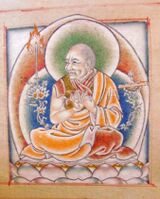'gos lo tsA ba gzhon nu dpal
'gos lo tsA ba gzhon nu dpal on the DRL
| Wylie | 'gos lo tsA ba gzhon nu dpal |
|---|---|
| English Phonetics | Gö Lotsāwa Zhönu Pal |
| Sort Name | Gö Lotsāwa |
- ཡིད་བཟང་རྩེ་བ་
- མགོས་ལོ་ཙཱ་བ་གཞོན་ནུ་དཔལ་
- yid bzang rtse ba
- mgos lo tsA ba gzhon nu dpal
- 'gos lo tsā ba gzhon nu dpal
| Birth: | 1392 |
|---|---|
| Death: | 1481 |
| Place of birth: | grong nag me dgu ('phyongs rgyas) |
Tibetan calendar dates
| Day | |
|---|---|
| Month | |
| Gender | Male |
| Element | Water |
| Animal | Monkey |
| Rab Jyung | 7 |
- Religious Affiliation
- Karma Kagyu
- Teachers
- Shamarpa, 3rd · Karmapa, 5th · Tsong kha pa · Rong ston shes bya kun rig
- Students
- Shamarpa, 4th · Karmapa, 7th
Other Biographical info:
- BDRC Link
- https://www.tbrc.org/#!rid=P318
- Treasury of Lives Link
- https://treasuryoflives.org/biographies/view/Go-Lotsawa-Zhonnu-Pel/5500
- Treasury of Lives Excerpt
- Go Lotsāwa Zhönnu Pel ('gos lo tsA ba gzhon nu dpal) was born in a small town called Drongnak Megu (grong nag me dgu) in Chonggye region ('phyongs rgyas) of southern Tibet in 1392, the water-monkey year in the seventh sexagenary cycle. He was born to the Gö clan ('gos). His father was called Goton Jungne Dorje ('gos ston 'byung gnas rdo rje) and his mother was named Sitar Kyi (srid thar skyid). Go ('gos) was also the name of their family; Zhonnu Pel was the third among their eight children . . .
Gö Lotsāwa is perhaps best known for this massive history of Buddhism in Tibet, The Blue Annals (deb ther sngon po) that he started in 1476 at the age of eighty-four, dictating to attendants, and completed in 1478. It includes vital information about early Tibetan history and religious lineages. Gö Lotsāwa drew from earlier works such as The Red Annals, written in 1346 by Tselpa Situ Kunga Dorje (tshal pa si tu kun dga' rdo rje, 1309-1364), and Butön Rinchen Drup's (bu ston rin chen grub, 1290-1364) History of Buddhism, and also many other earlier historical records. The work was originally preserved and woodblocks carved at Yangpachen (yangs pa chen) near Lhasa, which were later transferred to Kundeling (kun bde gling) in Lhasa. A set of woodblocks were also carved at Ganden Chokhorling in Amdo (a mdo dga' ldan chos ’khor gling).
- Himalayan Art Resources Link or Other Art Resource
- https://www.himalayanart.org/search/set.cfm?setID=976
- Wiki Pages
- 'gos lo tsA ba gzhon nu dpal on the DRL
- 'gos lo tsA ba gzhon nu dpal on the LIB
- 'gos lo tsA ba gzhon nu dpal on the BNW
- Person description or short bio
Expand to see this person's philosophical positions on Buddha-nature.
| Is Buddha-nature considered definitive or provisional? | |
|---|---|
| Position: | Definitive |
| Notes: | * "Thus the last two dharmacakras are not different in terms of ontology. Still, the third dharmacakra differs in the fine distinctions it offers, and for this reason alone it has—contrary to the first two—definitive meaning (nītārtha), and so outshines the second dharmacakra by an uncountable factor." Mathes, K., A Direct Path to the Buddha Within, p. 369.
|
| All beings have Buddha-nature | |
| Position: | |
| If "Qualified", explain: | |
| Notes: | |
| Which Wheel Turning | |
| Position: | Third Turning |
| Notes: | |
| Yogācāra vs Madhyamaka | |
| Position: | Yogācāra |
| Notes: | Though his own view is based on Mahāmudrā, for which he asserts RGV is an important basis. |
| Zhentong vs Rangtong | |
| Position: | |
| Notes: | |
| Promotes how many vehicles? | |
| Position: | |
| Notes: | |
| Analytic vs Meditative Tradition | |
| Position: | Meditative Tradition |
| Notes: | "That Zhönu Pal comments on the Ratnagotravibhāga from within the tradition of meditation is also clear from his colophon:
The Dharma master Drigungpa [Jigten Sumgön] rejoiced in Jé Gampopas statement that the basic text of these mahāmudrā instructions of ours is the [Ratnagotravibhāga] Mahāyānottaratantraśāstra composed by the illustrious Maitreya; and since it is evident that the notes to [his] Uttaratantra explanations, the points he makes when presenting the three dharmacakras, and also the explanations deriving from Sajjana’s heart disciple Tsen Kawoché, are [all] in accordance with mahāmudrā proper, I have relied on them and have made [this] clear to others as best as I could. (DRSM, 574.9-12)" Mathes, K., A Direct Path to the Buddha Within, p. 368. |
| What is Buddha-nature? | |
| Position: | Tathāgatagarbha as Mind's Luminous Nature |
| Notes: | * "The tathāgata heart’s own essence is not a nonimplicative negation but is the element of basic awareness." Brunnhölzl, K., When the Clouds Part, p. 69.
|
| Svātantrika (རང་རྒྱུད་) vs Prāsaṅgika (ཐལ་འགྱུར་པ་) | |
| Position: | |
| Notes: | |
| Causal nature of the vajrapāda | |
| Position: | |
